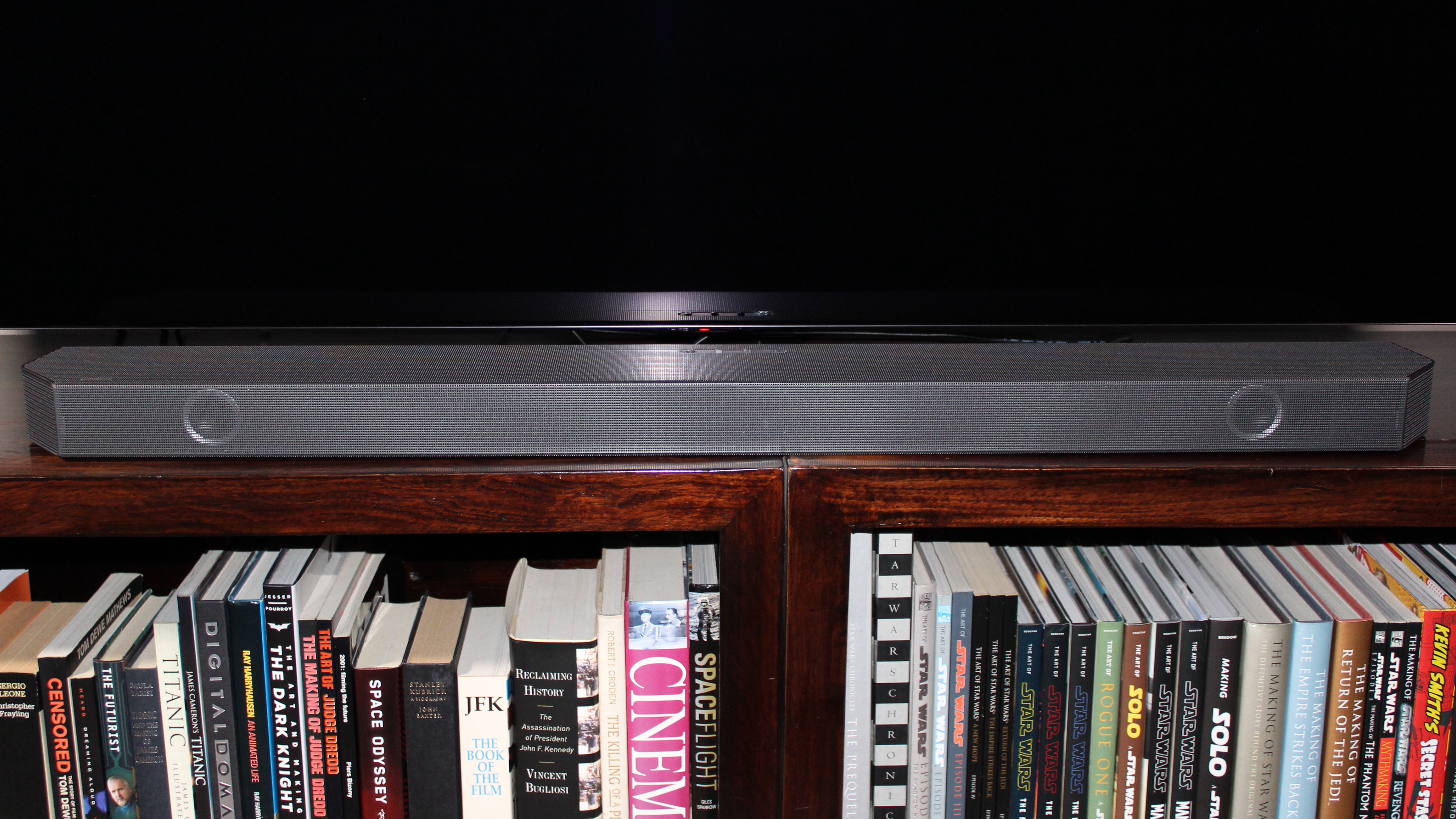Samsung HW-Q800B review: an excellent higher-end soundbar and sub combo
Samsung’s 5.1.2-channel soundbar delivers width and height, with the option to add rears


Feature-packed and highly immersive, this Dolby Atmos/DTS:X soundbar will please the most demanding film fan with its object-based heroics. The subwoofer sometimes borders on unruly, but this 5.1.2 system is hard to resist, even if you don’t intend to pair it with a Samsung TV.
-
+
Dolby Atmos and DTS:X support
-
+
Room calibration
-
+
Optional rear speakers
-
-
Bass can overpower
Why you can trust T3

The Samsung HW-Q800B sits towards the top of the brand’s soundbar range, offering many of the features found on the flagship Q990B model but without the corresponding premium.
A 5.1.2-channel speaker layout delivers front left/centre/right channels, a pair of side channels, twin upfiring channels, and a wireless subwoofer – although if that isn’t immersive enough there’s the option to add wireless rear speakers with up-firers for a 7.1.4-channel system.
Film fans should be delighted, but will you need a Samsung TV to fully appreciate this soundbar’s charms, marking this out as one of the best soundbars for Samsung TVs? Find out as our Samsung Q800B review reveals all…
SAMSUNG HW-Q800B: PRICE & AVAILABILITY
The Samsung HW-Q800B might sit towards the upper end of the brand’s soundbar range, but a recent price drop means you can pick it up for a list price of £699/$699. That’s the same outlay as the 3.1.2-channel HW-Q700B, making the Q800B something of a bargain.
For an extra £249/$199 you can add the optional wireless SWA-9500S rear speakers to the HW-Q800B, turning it into a 7.1.4-channel system and making it preferable to Samsung’s HW-Q900B, which might offer a 9.1.4-channel system but will set you back £1,099/$899 overall.
SAMSUNG HW-Q800B REVIEW: FEATURES & WHAT’S NEW?

The Samsung HW-Q800B is a feature-packed soundbar that builds on the success of 2021's HW-Q800A, but ups the speaker layout from 3.1.2 to 5.1.2 channels. As mentioned, there’s also an upgrade path by adding surround and rear height channels if you fancy greater immersion.
The soundbar supports Dolby Atmos and DTS:X object-based surround, plus their respective legacy versions, while for music lovers there's a host of high-res audio formats. There’s also built-in Alexa smarts that not only provides easy access to more music, but a degree of voice control.
Get all the latest news, reviews, deals and buying guides on gorgeous tech, home and active products from the T3 experts
The HW-Q800B now incorporates built-in microphones in the soundbar and subwoofer, allowing the 'SpaceFit Sound Gen II' feature to calibrate the audio without the assistance of a Samsung TV. The Q800B measures the acoustics of the room, equalising and optimising the sound accordingly.
There’s a number of sound modes, including AI Adaptive, Standard, Surround, and Game. There’s also Active Voice Amplifier for enhanced dialogue, and Samsung’s Q Symphony, which allows the soundbar to integrate with a supporting Samsung TV’s speakers to expand the soundstage.
SAMSUNG HW-Q800B REVIEW: AUDIO PERFORMANCE

The Samsung HW-Q800B does an excellent job of demonstrating its superiority over the HW-Q800A or the similarly-priced HW-Q700B, with a crisp, bold and solid front soundstage that will complement even the largest TV screen. The addition of side-firing drivers immediately generates greater width, while up-firing drivers effectively create the illusion of overhead channels.
The use of high-quality components inside the well-constructed cabinet ensures there’s a pleasing musicality to the overall delivery, while the dedicated centre channel provides clear and focused delivery of dialogue. The general tuning of the system is natural right out of the box, and the SpaceFit Sound Gen II calibration feature corrects for the more egregious aspects of the room.
The rear-ported subwoofer has plenty of low-end extension, and is surprisingly nimble on its feet, with a responsive and controlled delivery. The automated room correction effectively integrates it with the other speakers in the system, but avoid positioning it in a corner, and you may need to tweak the sub level to ensure the overall bass doesn’t swamp the other speakers.

The HW-Q800B includes a number of preset sound modes, with Standard offering the best all-round choice for most content, including music. This mode renders the audio without applying any processing, resulting in a clean, clear and nuanced delivery; while the Adaptive Sound mode applies on-the-fly processing to make full use of the multi-channel speaker array.
When it comes to Dolby Atmos and DTS:X object-based audio the results are pleasingly immersive, although the delivery is understandably front-heavy. However, there’s precise placement of effects around the screen, with a greater sense of dimensionality. Those seeking full envelopment can add the optional rear speakers to create an immersive 7.1.4 channel system.
There are a number of other acoustic features, including Voice Enhance, which makes dialogue easier to hear, and Virtual Surround. There’s also a Sync adjustment, in case of any lip sync issues. The Q800B supports hi-res audio, and is a very capable system for two-channel music, with excellent stereo separation and imaging, combined with precise placement of instruments.
SAMSUNG HW-Q800B REVIEW: DESIGN AND USABILITY

The Samsung HW-Q800B uses an angular design, with a matte black finish and a mesh grille that covers all the speakers. The build quality is good, if not exceptional, but the metal grilles ensure it’s fairly robust. The soundbar is wide enough to match larger screen sizes, with dimensions of 1111 x 60 x 120mm (WxHxD), and a weight that clocks in at 5.1kg.
The wireless subwoofer is big and beefy number, with a side-firing driver and rear bass port. The woofer is finished in matte black, and there’s black fabric over the driver. It measures 210 x 403 x 403mm (WxHxD), and weighs in at 9.8kg.
Connectivity is good with an HDMI input and an output that supports eARC. An HDMI input is an important hook-up option for Blu-ray Disc owners wanting to enjoy DTS:X, while both HDMI ports pass 4K/60p, ALLM and a full house of HDR formats (HDR10, HLG, HDR10+ and Dolby Vision). Sadly there’s no support for 4K/120p or VRR, which will disappoint next-gen gamers.
The only other physical connection is an optical digital input, but wireless connectivity is well served with Wi-Fi, Bluetooth, and Apple AirPlay 2. There’s also Samsung’s Tap Sound for quick and easy Bluetooth pairing with the brand’s Galaxy mobiles, while support for Amazon Alexa and Google Assistant adds a degree of onboard smarts.

Samsung doesn’t include an onscreen display, but there is an LED display that’s thankfully back on the front rather than at the top, where it was located on previous generations. This makes it easier to see, although because the display is behind the mesh grille, it can be hard to read.
There are still some basic controls on the top, but for setup and operation you’re likely to use the provided remote or the SmartThings app. The remote closely resembles the zapper that comes with Samsung’s TVs, and includes all the necessary buttons for setting up and controlling the ‘bar.
The app is equally effective, but it’s a shame not all the menu options are included on it, because it means you have to use the display for functions such as tweaking the channel levels. Thankfully the inclusion of SpaceFit Sound Gen II makes optimising the system for your room a veritable slice of gateaux, and the resulting soundstage is tight and controlled, with well-integrated bass.
SAMSUNG HW-Q800B REVIEW: VERDICT

The Samsung HW-Q800B is a well-appointed and highly capable soundbar that’s sure to please fans looking for a big, cinematic delivery. The soundstage is understandably front-heavy, but there’s plenty of width, height and scale to the presentation. The subwoofer is excellent, although some tweaking may be required to ensure its bass doesn’t over-power the rest of the system.
If you feel the need for greater immersion, you can add wireless rear surround and height channels, and the Q800B can also integrate with certain Samsung TVs using Q Symphony. However, you don’t need a Samsung TV to enjoy the benefits of this soundbar’s Atmos and DTS:X sonics, while the built-in audio calibration delivers a cohesive system optimised for your room.
A host of other features rounds out an accomplished soundbar and sub combo that comes highly recommended, and thanks to recent price drops it’s also a best buy.
Also consider
If you really want to save some money, you could pick-up last year’s HW-Q800A, but it’s only a 3.1.2-channel system and requires a modern Samsung TV to get the most out of it.
Otherwise it’s hard to find another soundbar to compete with the Q800B at this price, and since it only costs an extra £250/$250 to add the wireless rears for a 7.1.4 system, this model remains competitive even when compared to Samsung’s higher-end HW-Q990B.

Steve Withers is a professional calibrator and freelance journalist who regularly contributes to T3, reviewing audio and video products, and writing articles. Steve has been writing about audio and video products for over ten years and, along with T3, he also contributes to TechRadar, Trusted Reviews, Expert Reviews, AVForums, Pocket-lint, Home Cinema Choice, and Wired. Steve is Level 2 certified with THX, the Imaging Science Foundation (ISF) and the Home Acoustics Alliance (HAA). As such, he remains abreast of all AV technology developments and the latest industry standards as we transition into a new era in home video and audio.